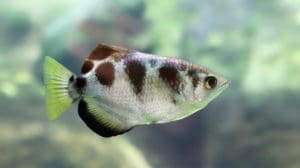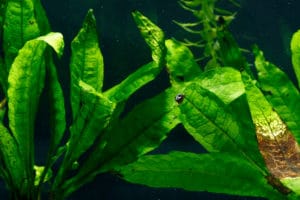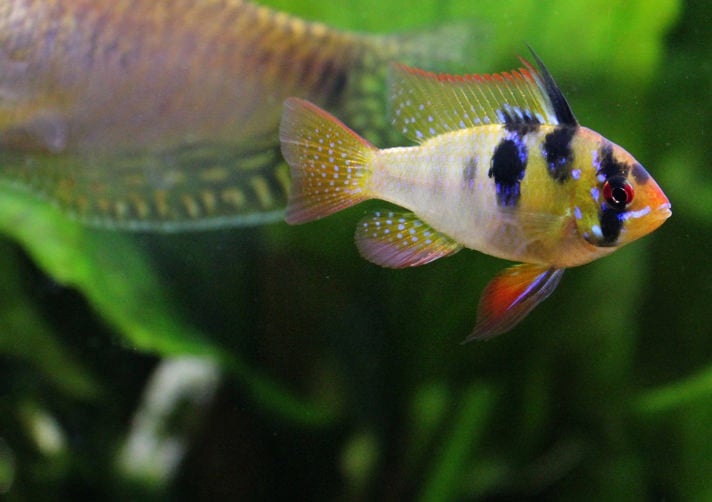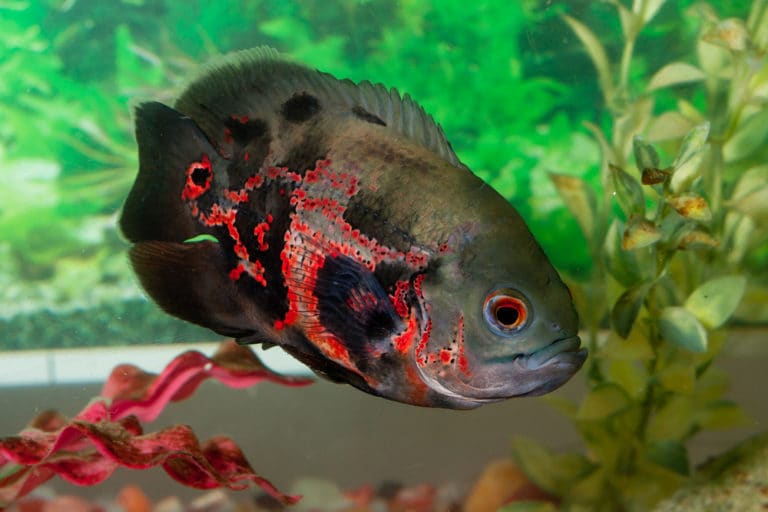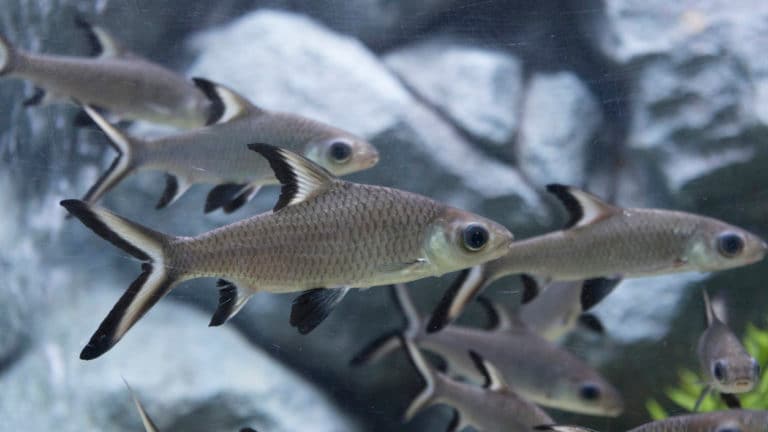A jerking movement sparks the attention of a lurking archerfish. With great interest, the deadly predator takes a 45-degree angle to the surface and subtly adjusts to the gentle current. Like a periscope, just the tip of the hunter’s mouth betrays its presence.
Having honed in on this appetizing target more than a minute earlier, the archerfish patiently waits for the right combination of a “clear” shot, distance and a suitable impact area for the prey to fall. With lightning speed, a powerful jet of water tears the bug from its perch, and in the blink of an eye — it is gone.
Archerfish Natural History
These are the most intelligent fish I have ever encountered in 35 years of aquariumkeeping. Archerfish (Toxotes spp., pronounced “Tox-oh-tays”) are well known for their extraordinary hunting skills. The scientific name —Toxotes — is derived from the Greek word for archer or bowman.
Remarkably, like a football coach, they implement the principles of offense, defense and deception. It is no accident that a famous World War II submarine, the USS Archerfish, was appropriately named after these sagacious hunters. Most archerfish available to the hobbyist are brackish, warm-water, tributary dwellers. They have a vast distribution ranging from southeastern Asia through the western Pacific to northern Australia.
There are reported to be at least seven (and possibly as many as 12) species of archerfish with two species — Toxotes jaculatrix and T. chatareus — being the most commonly available. In the wild these species can grow to about a foot in length. In captivity they usually only grow to about 6 or 7 inches. Tributary life exposes archerfish to a wide range of water conditions that afford them an opportunity to traverse between brackish and fresh water. Since T. jaculatrix and T. chatareus are truly brackish species, they do best in a salinity range of between 6 to 10.
A third species — Toxotes microlepis — is sometimes available. Unlike T. jaculatrix and T. chatareus, T. microlepis is really a freshwater species that will tolerate only slightly brackish water, perhaps in the salinity range of 1 to 5. Toxotes microlepis grows to 5 inches in length when kept in captivity. There are no reports of hobbyists breeding archerfish. Much to their credit, two organizations in Australia have successfully bred archerfish using hormones. This is a very encouraging development. Perhaps, they will share their breeding techniques so that hobbyists can replicate their successes.
Bringing The Archerfish Home
Before acquiring my archerfish, I exhaustively researched their natural habitat and consulted with biologists from public aquariums before developing a suitable and realistic archerfish environment. Readers familiar with my work know that I always try to present new, “how-to-do” material that can be replicated by hobbyists. I didn’t realize the archerfish would show me how to do it!
Archerfish are most often seen in public fish aquariums. Many of these venues commendably replicate a tide pool or a mangrove backwater and are usually viewed from above. The advantage of this arrangement is quickly realized when the staff feeds their archerfish, which results in the guests getting a miniature shower from these world-class performers. The dolphin act has nothing on these guys!
I wanted to create an opportunity to view my archerfish from the side and, to a lesser extent, from the top. For now, I use a 55-gallon aquarium, but I will transition to a 90-gallon tank as the fish grow. Archerfish are schooling fish and enjoy open swimming space. I used tidal sand to a depth of 2 inches for a substrate and planted the tank with Java fern and Anubias attached to driftwood.
Filtration consists of a Magnum 350 Pro canister filter with the Bio-Wheel option. A secondary biological filter was constructed using an AquaClear Powerhead coupled to a dual sponge filter. Two 150-watt Visi-Therm Stealth Heaters maintain a temperature of 80 degrees Fahrenheit.
The tank has about 30 gallons of water, and driftwood logs protruding about 6 inches above the surface are used on each end of the aquarium. For aesthetics, a houseplant (Philodendron spp.) was draped down onto the left log. A glass top totally covers the tank and is needed because archerfish are jumpers and love to spit. Water salinity is maintained between 5 and 10.
Acquiring an Archerfish
After setting up and cycling my 55-gallon archerfish tank, I contacted a few large suppliers to check on the availability of archerfish. None were in stock at the time, but I added my name to a waiting list. They all told me the archerfish would be shipped in fresh water, regardless of the species, which seemed kind of unusual to me.
I called a local mom-and-pop fish store in Kansas City, and they gladly took my order for four archerfish. Much to my delight, the 2.5-inch-long juveniles arrived two days later. Interestingly, these fish were shipped in brackish water with a salinity of 8. I discovered what the salinity was when I tested the shipping-bag water for pH and other parameters. I was very fortunate to have both brackish and freshwater quarantine tanks available. And talk about incredible luck, my brackish-water quarantine tank’s salinity was exactly 8. In the grand scheme of things, this is not very brackish. Placing brackish-water fish, already stressed from shipping, into fresh water without a substantial acclimation period could have resulted in losses. The archerfish cost about $20 each.
Archerfish Species
Toxotes jaculatrix – brackish water to salinity of 10
T. chatareus – brackish water to salinity of 10
T. microlepis – fresh water to slightly brackish to salinity of 1 to 5
T. blythi – fresh water
T. lorentzi – fresh water
T. oligolepis – fresh water
T. kimberleyensis – fresh water
Along with testing the water parameters upon arrival, make sure to type your species. Even though my archerfish were shipped in brackish water, they actually turned out to be T. microlepis — a freshwater to slightly brackish species. To avoid shocking my new fish, I initially maintained the salinity of 8 and began reducing the salt content slowly over a period of days. I also went ahead and synchronized the salinity reduction in both my quarantine tank and main tank.
Wet Walls
On day four of a two-week quarantine, I noticed the wall behind the aquarium was wet. It looked like a squirt gun had been fired about 3 feet above the tank. The quarantine tank was completely covered with a full hood thereby ruling out filter splash. Further examination revealed evidence of a spider on the underside of the access flap. The archerfish must have fired at the spider with the water exiting through a tiny gap between the access flap and the glass top. Seeing this, I modified the glass top of the 55-gallon tank to hopefully eliminate wet walls and carpets.
Seeing Them Eat
My “comfort zone” was perforated the day after releasing one of the fish into the main tank; clearly I was holding a tiger by the tail. A single cricket was gently positioned on a log in such a manner that it would absolutely not be visible from the water. The cricket lay motionless and silent for more than two minutes.
Astonishingly, within moments of introducing the cricket, the archerfish abandoned its lackadaisical swimming and began circling the log; it was clearly hunting its prey.
How could it have possibly known of the cricket’s presence?
It was like those hungry cartoon sharks circling silly characters as they hug each other in a leaky boat. I observed the archerfish breaking the water’s surface with the tip of its mouth. Perhaps it is able to smell through the air?
The cricket eventually stirred, and the archerfish’s movements changed from a smooth circling motion to rapid, calculated positioning. The cricket was exposed twice for an easy shot, but the archerfish did not fire. Then it occurred to me that the fish was positioning the shot so that the prey would fall into open water rather than onto the low-hanging Philodendron vine. Darting to a new position, the archerfish fired a powerful jet of water and narrowly missed its mark, giving the cricket a chance to flee to a lower branch.
Changing strategies, the archerfish dove down toward the tank bottom, turned, picked up tremendous speed and bolted out of the water sliding sideways over the branch and simply overwhelmed its unsuspecting prey.
Seeing Archerfish Compete
I introduced a second archerfish two days later and removed the Philodendron that draped into the tank. The plant looked great, but it allowed crickets to escape from the aquarium. Within a day, the second archerfish adjusted to its new surroundings, and the pair began schooling. I placed a cricket on the highest point of a log and assumed the archerfish would quickly react to such an easy shot. But I was flabbergasted at their response.
Rather than simply firing at this delectable meal, they were jockeying for position and aggressively cutting each other off! It was like a football coach using a slate with X’s and O’s. Archerfish One feigned moving left, but it actually went to the right and tricked Archerfish Two out of its shooting position. Archerfish One then fired a shot and, without assessing to see if it hit its intended target, it sprinted to the precise point of water impact and enjoyed a tasty meal.
In every case the archerfish seem to know exactly where the food will impact the water — be it a cricket falling from a water shot or me simply tossing in some fish food. They are extremely cunning, master strategists with the innate gift of geometricians. While archerfish are belligerent hunters, they hang out together and make very good tankmates.
Feeding Time
More than a pair results in a situation where they just can’t be given the personal attention that these spectacular fish deserve. Archerfish eat anything. I feed mine a diverse diet of crickets, mealworms, live brine shrimp and other live foods as well as flake food and several frozen fish foods.
Archerfish have huge mouths that can accept extraordinarily large prey items. They are able to shoot water due to a unique V-shaped upper palate that the fish presses its tongue against, which in turn creates a water tube for the high-pressure stream.
Lessons Learned
Positive identification of your archerfish species is essential. While my archerfish were unexpectedly shipped in brackish water, I later identified my collection as T. microlepis, which is basically a freshwater dweller.
While it is entertaining to watch archerfish shoot for food, use good judgment and do not overfeed them. Children love watching them eat, but you can explain to them that they are not toys and that the fish will become ill if fed too much. One public aquarium staff member mentioned they overfed their archerfish while entertaining a cheering crowd, and the archerfish got quite ill as a result.
Keep your tank totally covered. My archerfish jumped more than 8 inches to capture crickets and sprayed water more than 3 feet beyond the tank when hunting the spider.
Conclusion
Unless you are absolutely sure of the water conditions, be prepared for your fish to arrive in either fresh or brackish water. It is best to have cycled freshwater and brackish quarantine tanks set up and ready to receive new arrivals. It is unlikely the beneficial bacteria will be able to adjust to a sudden change from fresh to brackish water.
While it looks great, dangling terrestrial vegetation into the tank is not a good idea because it enables crickets and other bugs to escape. Archerfish are aggressive feeders, and it is possible (and often probable) for one to devour all of the available food. Hand feeding ensures all of your archerfish get sufficient nourishment.
Archerfish “hit hard,” so use tweezers with blunted ends if feeding them by hand to avoid injuring their mouths. They will learn to recognize you and will position themselves if fed in the same spot daily.
Archerfish take on a dark or very faded color when stressed. If water parameters are good, check the temperature. They don’t like to get cold and 80 degrees is ideal.
These are very trusting fish. Avoid sudden movements, and they will tolerate you cleaning their tank without causing them stress. Be especially careful not to inadvertently “corner” a fish when cleaning, as it might panic.
One element of my long-term success with fishkeeping is having a very low bioload. I decided to only have two archerfish in one 55-gallon tank.
Archerfish are an excellent choice for the experienced aquarist. It was truly an honor having these animated and intelligent fish keeping me on staff as their concierge.
By: Stephen Noble
Featured Image: Henner Damke/Shutterstock.com
Share:
